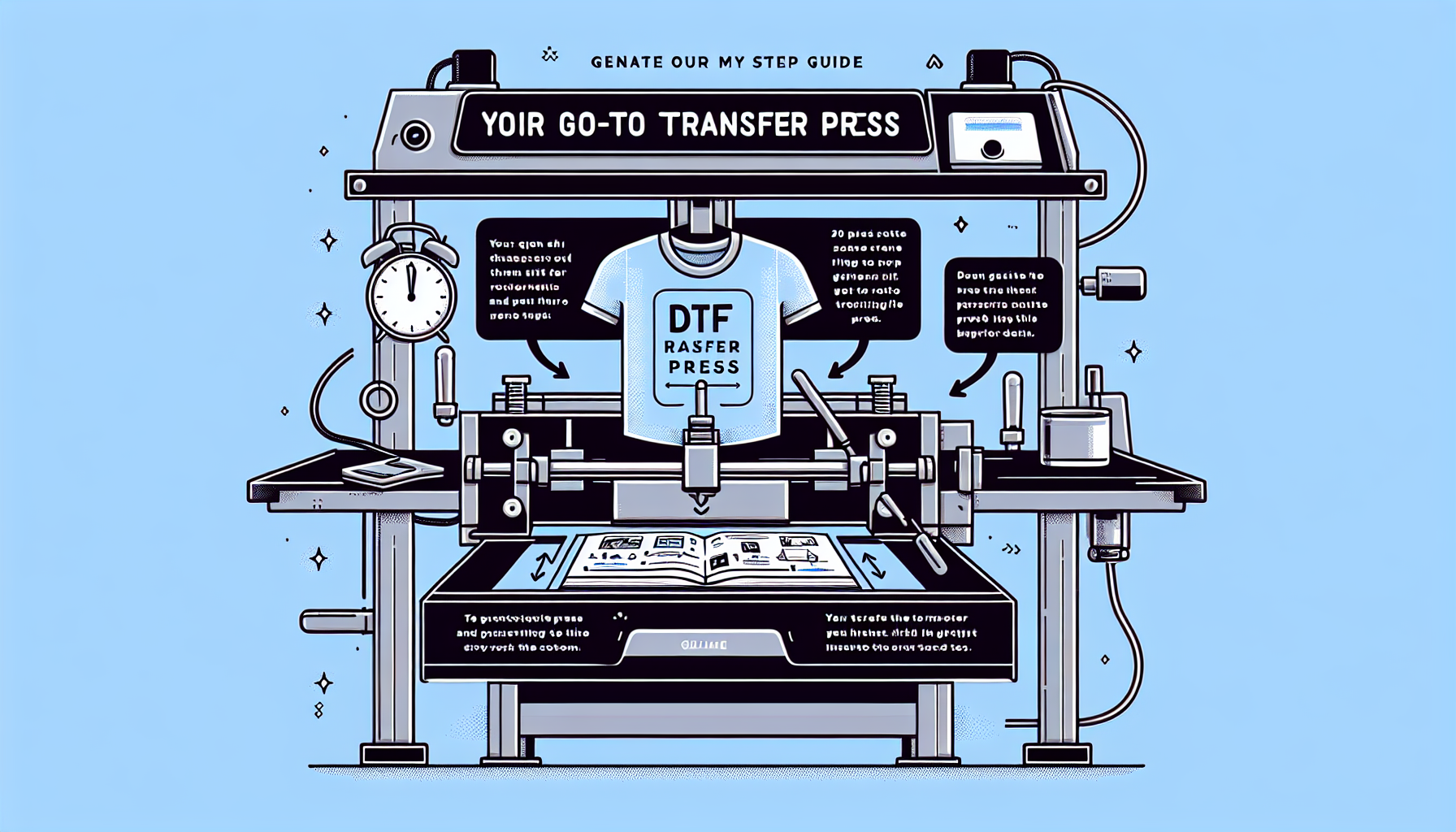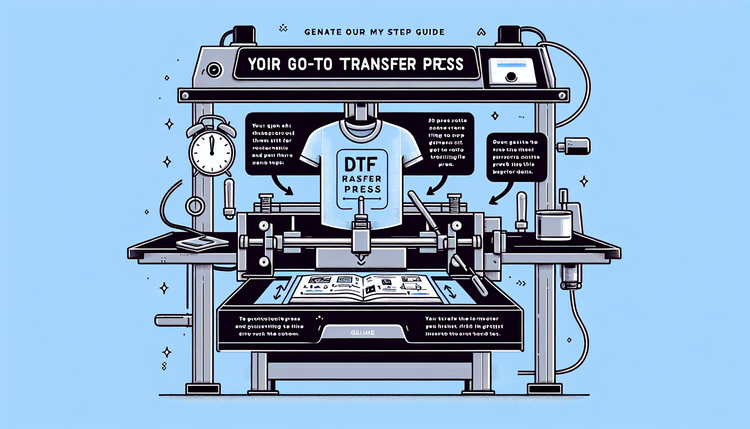Introduction to DTF Transfer Press Instructions

Importance of Understanding DTF Transfer Press Instructions
Mastering DTF transfer press instructions is critical for achieving high-quality, long-lasting custom apparel. Proper technique ensures optimal adhesion, vibrant colors, and durability, elevating your printing business and impressing your customers.
Overview of the Blog Content
Embark on a journey through the world of DTF transfers, exploring essential equipment, step-by-step pressing instructions, best practices, troubleshooting tips, and how DTF Transfer Zone can support your business endeavors.
Understanding DTF Transfers and Heat Presses
Direct-to-Film (DTF) transfers are a modern and versatile printing technique in which designs are printed directly onto a special film and then transferred onto garments or other substrates using a heat press machine. DTF transfers have gained significant popularity due to their ability to produce high-quality, vibrant, and durable prints on a wide range of materials.
The heat press machine plays a crucial role in DTF printing. It applies the necessary heat and pressure to transfer the printed design from the film onto the garment, ensuring proper adhesion and vibrant colors. By understanding the role of heat press machines in DTF printing, you can achieve consistent and professional results.
There are several advantages to using DTF transfers over traditional printing methods, such as screen printing and sublimation. Some of these benefits include:
- Greater flexibility: DTF transfers can be used on a wide range of materials, including cotton, polyester, and blends, without the need for special inks or treatments.
- High-quality prints: DTF transfers produce vibrant, full-color prints with excellent detail and resolution, outperforming many traditional printing techniques.
- Reduced setup time and costs: With no need for screens, films, or other setup materials, DTF transfers are a cost-effective and time-saving option for custom apparel printing.
- Eco-friendly: DTF inks are water-based, making them an environmentally friendly option compared to solvent-based inks used in other printing methods.
Overall, understanding the basics of DTF transfers and heat press machines is essential for harnessing their full potential and elevating your custom apparel business.
Required Materials and Equipment for DTF Transfer Pressing
To achieve professional and high-quality results with DTF transfers, it's essential to have the right materials and equipment on hand. Ensuring you're fully prepared will not only make the process smoother but also help you avoid any costly errors or setbacks. Let's take a look at the key components you'll need for successful DTF transfer pressing:
DTF Transfer Press Machine
A crucial piece of equipment for DTF transfer pressing is the heat press machine. This device applies the necessary heat and pressure to transfer the printed design from the film onto the garment. Make sure to invest in a reliable and accurate heat press machine that can maintain consistent temperature and pressure settings throughout the process.
DTF Inks and Supplies
High-quality DTF inks and supplies are vital for vibrant, long-lasting prints. Ensure you're using the right type of inks and adhesive powders specifically designed for DTF printing. This will not only optimize the print quality but also improve the durability and washability of the finished product.
T-shirts or Other Garments for Printing
Having a variety of garments on hand for printing is essential. DTF transfers work well on various materials such as cotton, polyester, and blends, so feel free to get creative with your choice of garments. Remember to select high-quality, comfortable, and durable materials that will showcase your designs and keep your customers satisfied.
Protective Sheets or Parchment Paper (Optional)
Using protective sheets or parchment paper during the pressing process can help protect your heat press machine and the garments from potential damage or staining. While not always required, these protective measures can ensure a smoother process and extend the life of your equipment and garments.
With the proper materials and equipment, you're now ready to embark on your journey into the world of DTF transfer pressing. By investing in high-quality supplies and following the correct techniques, you'll be well on your way to producing impressive custom apparel that will delight your customers.
Step-by-Step Guide to DTF Transfer Press Instructions
Following a systematic process is key to achieving professional results with DTF transfers. In this section, we'll guide you through each step of the process, ensuring a smooth and successful printing experience.
Preparing the Heat Press Machine
Before starting the actual printing process, it's crucial to set up your heat press machine correctly. This involves setting the appropriate temperature and time for the specific garment and transfer materials you're using. Consult the manufacturer's recommendations or guidelines for accurate settings. Additionally, adjusting the pressure of your heat press is essential to ensure proper adhesion and even transfer of the design.
Positioning the DTF Transfer on the Garment
Once your heat press is ready, it's time to position the DTF transfer on your garment. Take care to align the design accurately with the garment, considering factors like the garment's size, shape, and the intended placement of the design. Ensure proper placement and orientation to avoid any mistakes during the pressing process.
Pressing the DTF Transfer
With the transfer properly positioned, you can now proceed to the pressing step. If you're using a protective sheet or parchment paper, cover the transfer with it to shield your heat press and garment from potential damage or staining. Then, carefully lower the heat press and apply pressure, following the recommended time and temperature settings.
Cooling and Peeling the Transfer
Patience is key in this step! Wait for the transfer to cool down completely before attempting to peel off the transfer film. Gently remove the film, taking care not to damage the design or the garment in the process.
Final Press for Optimal Adhesion (If Necessary)
In some cases, a final press might be necessary to ensure optimal adhesion and durability of the printed design. If this step is needed, cover the printed design with a protective sheet or parchment paper and press the garment once more for a few seconds. This will help to further secure the design and provide a professional finish.
By following these step-by-step DTF transfer press instructions, you'll be well on your way to producing impressive custom apparel that showcases your designs and delights your customers.
Tips and Best Practices for DTF Transfer Pressing
Mastering the art of DTF transfer pressing requires a combination of skill, knowledge, and attention to detail. By following the tips and best practices outlined below, you'll be able to achieve professional results while also adding a touch of humor to your work.
Importance of Proper Temperature and Pressure Settings
It's no laughing matter when your design doesn't turn out as expected due to incorrect temperature and pressure settings. To avoid any comedy of errors, ensure you're using the recommended settings for your specific transfer materials and garment type. Remember, too hot, and you might end up with a scorched design, but too cold, and your transfer might not stick.
Ensuring the Garment is Flat and Wrinkle-Free Before Pressing
Imagine unveiling your newly printed custom apparel only to discover a wrinkly mess beneath the design. Not the kind of humor your customers are looking for! To avoid this, always make sure the garment is flat and wrinkle-free before pressing. A smooth surface is key to achieving a flawless print and keeping your clients happy (and laughing for the right reasons).
Proper Maintenance and Cleaning of the Heat Press Machine
Just like a stand-up comedian needs a clean stage to perform their best, your heat press machine needs proper maintenance and cleaning to deliver top-notch results. Regularly inspect and clean your machine to keep it in peak condition, ensuring consistent temperature and pressure. A well-maintained heat press is crucial for the success of your DTF transfer pressing endeavors, and it's no joke!
By following these tips and best practices, you'll be on your way to mastering the art of DTF transfer pressing, all while keeping a sense of humor. Remember, the key to success is a combination of skill, knowledge, and a touch of laughter to keep things light and enjoyable.
Troubleshooting Common Issues with DTF Transfer Pressing
While DTF transfer pressing can be an enjoyable and rewarding experience, it's not always smooth sailing. Sometimes, you may encounter some common issues that can turn your custom apparel printing into a comedy of errors. But fear not! In this section, we'll help you troubleshoot these issues and get your DTF transfer pressing act back on track.
Transfers Not Sticking to the Garment
It's a frustrating situation when your transfer refuses to stick to the garment, leaving you feeling like the punchline of a bad joke. To avoid this, ensure you're using the correct temperature, pressure, and time settings for your specific transfer and garment materials. Also, check that your adhesive powder is applied evenly and in the right amount. If all else fails, try using a different transfer film or adjusting your heat press settings to find the perfect balance for adhesion.
Transfers Peeling or Cracking After Washing
Discovering your freshly printed design peeling or cracking after a wash can feel like a cruel twist of fate. To avoid this washing machine tragedy, ensure proper adhesion by using the correct temperature, pressure, and time settings during the pressing process. Additionally, instruct your customers to wash their garments inside out, using cold water and a gentle cycle. This will help preserve the print and keep their custom apparel looking fresh and vibrant, just like your sense of humor.
Incomplete or Uneven Transfer of the Design
An incomplete or uneven transfer can make your design look like a failed attempt at abstract art. To prevent this, ensure your garment is flat and wrinkle-free before pressing. Also, double-check that your heat press machine is applying consistent pressure across the entire design. If necessary, adjust the pressure settings or invest in a higher-quality heat press to ensure even transfer and a professional finish.
By addressing these common issues, you can keep your DTF transfer pressing endeavors on track and maintain your reputation as a reliable and professional custom apparel printer. Remember, every comedian has an off night, but with perseverance and a touch of humor, you can bounce back and continue delighting your customers with top-notch custom apparel!
DTF Transfer Zone: Your One-Stop Solution for DTF Transfers and Supplies
When it comes to DTF transfers, finding a reliable and knowledgeable provider is no laughing matter. DTF Transfer Zone is your go-to source for all things DTF, offering an extensive range of products and services designed to help you achieve exceptional results while keeping your sense of humor intact.
Overview of DTF Transfer Zone Products and Services
DTF Transfer Zone offers custom DTF transfers, DTF ink, and DTF supplies, ensuring that you have everything you need for a successful and enjoyable printing experience. Their product lineup includes DTF transfer film, DTF inks, and DTF adhesive powder, as well as custom holiday gifts like sweatshirts, hoodies, pajama pants, and printed blankets. With a focus on quality and value, DTF Transfer Zone aims to be your trusted partner in the world of custom apparel printing.
Benefits of Choosing DTF Transfer Zone for Your DTF Needs
Choosing DTF Transfer Zone for your DTF transfer needs is a wise decision that comes with numerous benefits. With their 2-4 day processing time, free ground shipping on orders over $250, and same-day printing available, you can rest assured that your order will be handled promptly and professionally. Additionally, DTF Transfer Zone prioritizes customer satisfaction, offering custom DTF transfers with fast shipping, no setup or art fees, and no order minimums. It's no joke - DTF Transfer Zone is dedicated to providing top-notch service and unparalleled quality to their customers.
Call-to-Action: Explore DTF Transfer Zone's Wide Range of Custom Transfers, Inks, and Supplies
It's time to take your custom apparel printing game to the next level with DTF Transfer Zone. Explore their extensive range of custom transfers, inks, and supplies to find the perfect solutions for your printing needs. With their commitment to quality, value, and customer satisfaction, DTF Transfer Zone is the ideal partner for your DTF printing endeavors. Don't miss out on the opportunity to elevate your business and impress your customers - visit DTF Transfer Zone today!
Mastering DTF Press Perfection
In this guide, we've outlined the importance of understanding and following proper DTF transfer press instructions to achieve professional, vibrant, and durable custom apparel. With the right knowledge, equipment, and attention to detail, you're now ready to explore the world of DTF printing and elevate your custom apparel business. Don't miss out on the opportunity to impress your customers with top-notch designs and outstanding service. Visit DTF Transfer Zone today to explore their wide range of custom transfers, inks, and supplies.

